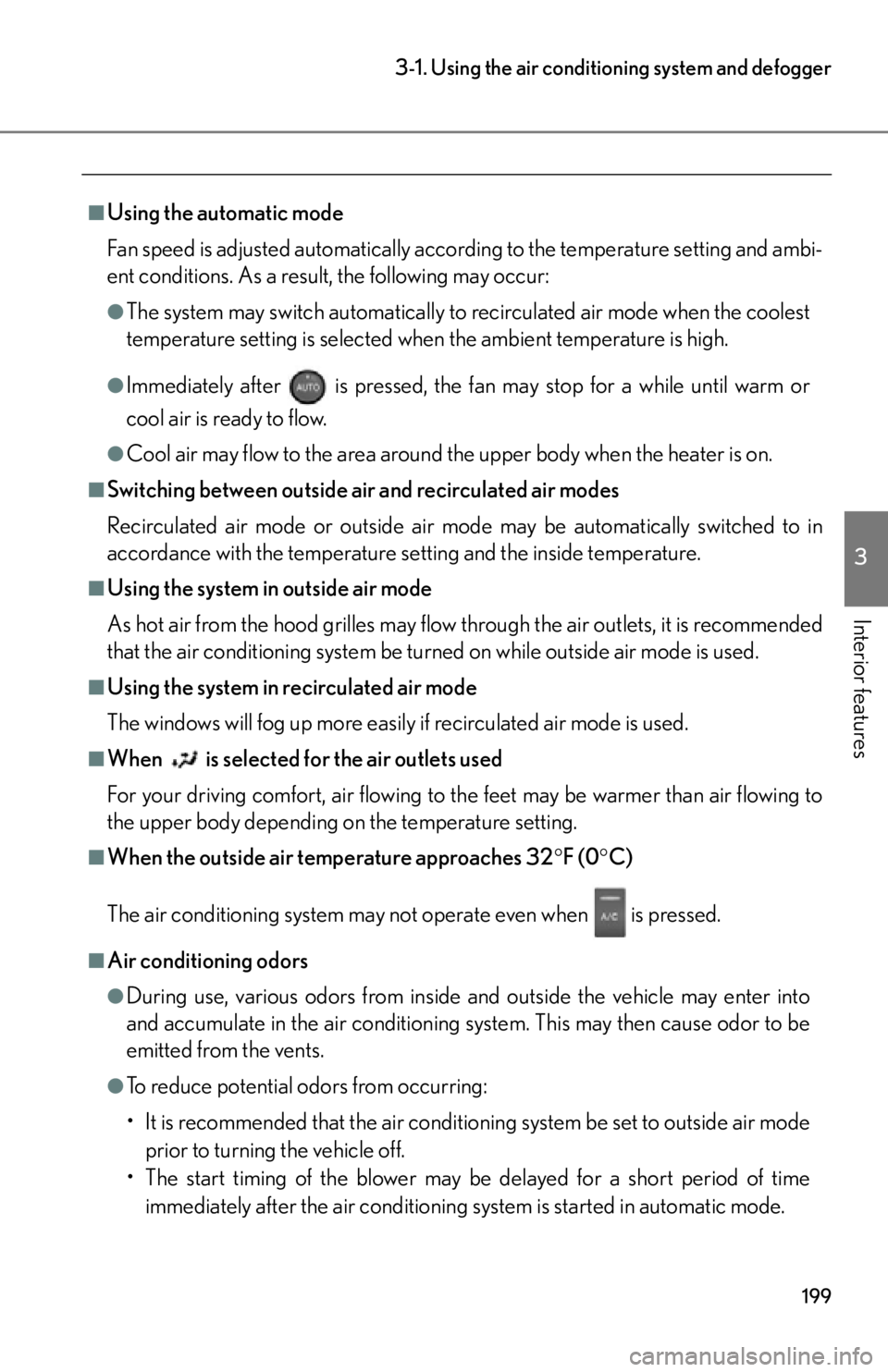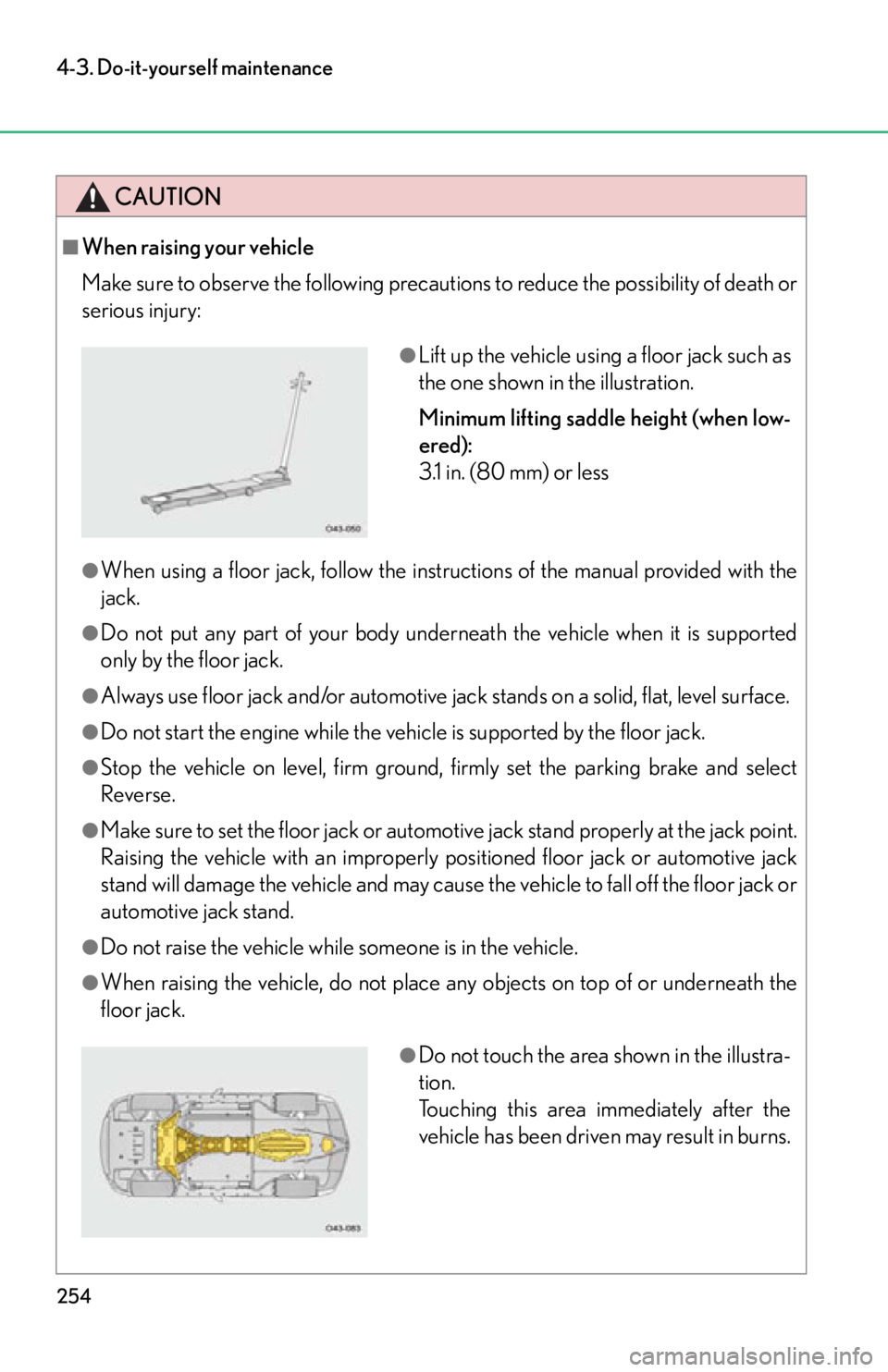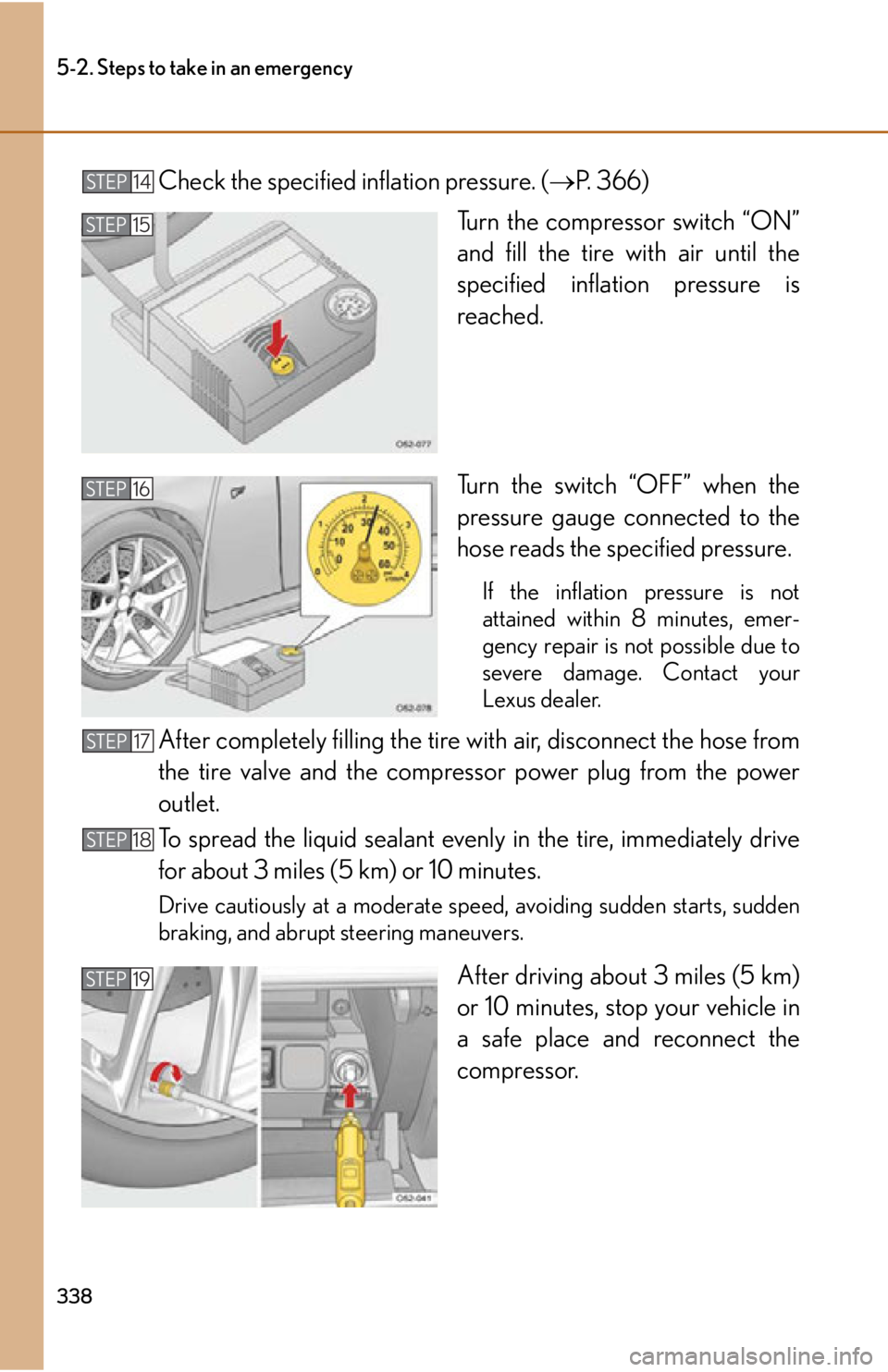2012 Lexus LFA stop start
[x] Cancel search: stop startPage 171 of 420

169
2-4. Using other driving systems
2
When driving
CAUTION
■The ABS does not operate effectively when
●Tires with inadequate gripping ability are used.
●The vehicle hydroplanes while driving at high speed on wet or slick roads.
■Stopping distance when the ABS is operating will exceed that of normal condi-
tions
The ABS is not designed to shorten the vehicle’s stopping distance. Always main-
tain a safe distance from the vehicle in front of you in the following situations:
●When driving on dirt, gravel or snow-covered roads
●When driving over bumps in the road
●When driving over roads with potholes or roads with uneven surfaces
■TRAC may not operate effectively in some conditions
Directional control and power may not be ac hievable while driving on slippery road
surfaces, even if the TRAC system is operating.
Do not drive the vehicle in conditions where stability and power may be lost.
■Hill-start assist control does not operate effectively in some conditions
Do not overly rely on the hill-start assist co ntrol. The hill-start assist control may not
operate effectively depending on the grad e of incline and on roads covered with
ice.
■If the slip indicator flashes while driving
The slip indicator flashes to indicate that ABS, VSC, TRAC or hill-start assist con-
trol is operating. Always drive carefully. Reckless driving may cause an accident.
Exercise particular care when the indicator light flashes.
■When the VSC/TRAC systems are turned off
Be especially careful and drive at a speed appropriate to the road conditions. As
these are the systems to help ensure vehicl e stability and driving force by automati-
cally controlling the brakes and engine ou tput, do not turn the VSC/TRAC systems
off unless necessary.
Page 194 of 420

192
3-1. Using the air conditioning system and defogger
■Using the automatic mode
Fan speed is adjusted automatically accord ing to the temperature setting and ambi-
ent conditions. As a result, the following may occur:
●The system may switch automatically to recirculated air mode when the coolest
temperature setting is selected when the ambient temperature is high.
●Immediately after is pressed, the fan may stop for a while until warm or
cool air is ready to flow.
●Cool air may flow to the area around the upper body when the heater is on.
■Switching between outside air and recirculated air modes
Recirculated air mode or outside air mode may be automatically switched to in
accordance with the temperature setting and the inside temperature.
■Using the system in outside air mode
As hot air from the hood grilles may flow through the air outlets, it is recommended
that the air conditioning system be turned on while outside air mode is used.
■Using the system in recirculated air mode
The windows will fog up more easily if recirculated air mode is used.
■When is selected for the air outlets used
For your driving comfort, air flowing to th e feet may be warmer than air flowing to
the upper body depending on the temperature setting.
■When the outside air temperature approaches 32 F (0C)
The air conditioning system may not operate even when “A/C” is selected on the
operation screen.
■Air conditioning odors
●During use, various odors from inside and outside the vehicle may enter into
and accumulate in the air conditioning sy stem. This may then cause odor to be
emitted from the vents.
●To reduce potential odors from occurring:
• It is recommended that the air conditioning system be set to outside air mode
prior to turning the vehicle off.
• The start timing of the blower may be delayed for a short period of time immediately after the air conditioning system is started in automatic mode.
Page 201 of 420

199
3-1. Using the air conditioning system and defogger
3
Interior features
■Using the automatic mode
Fan speed is adjusted automatically according to the temperature setting and ambi-
ent conditions. As a result, the following may occur:
●The system may switch automatically to recirculated air mode when the coolest
temperature setting is selected when the ambient temperature is high.
●Immediately after is pressed, the fan may stop for a while until warm or
cool air is ready to flow.
●Cool air may flow to the area around the upper body when the heater is on.
■Switching between outside air and recirculated air modes
Recirculated air mode or outside air mode may be automatically switched to in
accordance with the temperature se tting and the inside temperature.
■Using the system in outside air mode
As hot air from the hood grilles may flow through the air outlets, it is recommended
that the air conditioning system be turned on while outside air mode is used.
■Using the system in recirculated air mode
The windows will fog up more easily if recirculated air mode is used.
■When is selected for the air outlets used
For your driving comfort, air flowing to th e feet may be warmer than air flowing to
the upper body depending on the temperature setting.
■When the outside air temperature approaches 32 F (0C)
The air conditioning system may not operate even when
is pressed.
■Air conditioning odors
●During use, various odors from inside and outside the vehicle may enter into
and accumulate in the air conditioning sy stem. This may then cause odor to be
emitted from the vents.
●To reduce potential odors from occurring:
• It is recommended that the air conditioning system be set to outside air mode
prior to turning the vehicle off.
• The start timing of the blower may be delayed for a short period of time
immediately after the air conditioning system is started in automatic mode.
Page 256 of 420

254
4-3. Do-it-yourself maintenance
CAUTION
■When raising your vehicle
Make sure to observe the following precautions to reduce the possibility of death or
serious injury:
●When using a floor jack, follow the instructions of the manual provided with the
jack.
●Do not put any part of your body underneath the vehicle when it is supported
only by the floor jack.
●Always use floor jack and/or automotive jack stands on a solid, flat, level surface.
●Do not start the engine while the vehicle is supported by the floor jack.
●Stop the vehicle on level, firm ground, firmly set the parking brake and select
Reverse.
●Make sure to set the floor jack or automotive jack stand properly at the jack point.
Raising the vehicle with an improperly positioned floor jack or automotive jack
stand will damage the vehicle and may cause the vehicle to fall off the floor jack or
automotive jack stand.
●Do not raise the vehicle while someone is in the vehicle.
●When raising the vehicle, do not place any objects on top of or underneath the
floor jack.
●Lift up the vehicle using a floor jack such as
the one shown in the illustration.
Minimum lifting saddle height (when low-
ered):
3.1 in. (80 mm) or less
●Do not touch the area shown in the illustra-
tion.
Touching this area immediately after the
vehicle has been driven may result in burns.
Page 303 of 420

When trouble arises5
301
5-1. Essential informationEmergency flashers.............. 302
If your vehicle needs to be towed................................ 303
If you think something is wrong ..................................... 308
Fuel pump shut off system .................................... 309
Event data recorder ............... 310 5-2. Steps to take in an
emergency
If a warning light turns on or a warning buzzer
sounds... .................................. 312
If a warning message is displayed................................ 322
If you have a flat tire............... 332
If the engine will not start .... 343
If you lose your keys/ wireless remote
control transmitter ............. 344
If the parking brake cannot be released ............. 345
If the vehicle battery is discharged ............................ 348
If your vehicle overheats ...... 351
If the vehicle becomes stuck........................................ 354
If your vehicle has to be stopped in an
emergency ............................ 355
Page 311 of 420

5
When trouble arises
309
5-1. Essential information
Fuel pump shut off system
To minimize the risk of fuel leakage when the engine stalls or when an airbag
inflates upon collision, the fuel pump shut off system stops the supply of fuel to
the engine.
Follow the procedure below to restart the engine after the system is acti-
vated.
Turn the ignition switch to the “ACC” or “LOCK” position.
Restart the engine.
NOTICE
■Before starting the engine
Inspect the ground under the vehicle.
If you find that fuel has leaked onto the ground, the fuel system has been damaged
and is in need of repair. Do not restart the engine.
STEP1
STEP2
Page 322 of 420

320
5-2. Steps to take in an emergency
CAUTION
■Maintenance of the tires
Each tire, including the spare (if provided), should be checked monthly when cold
and inflated to the inflation pressure re commended by the vehicle manufacturer on
the vehicle placard or tire inflation pressu re label (tire and load information label).
(If your vehicle has tires of a different size than the size indicated on the vehicle
placard or tire inflation pressure label [tire and load information label], you should
determine the proper tire inflation pressure for those tires.)
As an added safety feature, your vehicl e has been equipped with a tire pressure
monitoring system (TPMS-tire pressure warning system) that illuminates a low tire
pressure telltale (tire pressure warning light) when one or more of your tires is sig-
nificantly under-inflated. Accordingly, when the low tire pressure telltale (tire pres-
sure warning light) illuminates, you should stop and check your tires as soon as
possible, and inflate them to the proper pressure. Driving on a significantly under-
inflated tire causes the tire to overheat and can lead to tire failure. Under-inflation
also reduces fuel efficiency and tire tread life, and may affect the vehicle's handling
and stopping ability.
Please note that the TPMS (tire pressure warning system) is not a substitute for
proper tire maintenance, and it is the driv er's responsibility to maintain correct tire
pressure, even if under-inflation has not reached the level to trigger illumination of
the TPMS low tire pressure telltale (tire pressure warning light).
Your vehicle has also been equipped with a TPMS (tire pressure warning system)
malfunction indicator to indicate when th e system is not operating properly. The
TPMS (tire pressure warning system) malfunction indicator is combined with the
low tire pressure telltale (tire pressure warning light). When the system detects a
malfunction, the telltale will flash for approximately one minute and then remain
continuously illuminated. This sequence will continue upon subsequent vehicle
start-ups as long as the malfunction exists . When the malfunction indicator is illumi-
nated, the system may not be able to detect or signal low tire pressure as intended.
TPMS (tire pressure warning system) malfunctions may occur for a variety of rea-
sons, including the installation of replacem ent or alternate tires or wheels on the
vehicle that prevent the TPMS (tire pres sure warning system) from functioning
properly. Always check the TPMS (tire pressure warning system) malfunction tell-
tale after replacing one or more tires or wheels on your vehicle to ensure that the
replacement or alternate tires and wheels allow the TPMS (tire pressure warning
system) to continue to function properly.
Page 340 of 420

338
5-2. Steps to take in an emergency
Check the specified inflation pressure. (P. 366)
Turn the compressor switch “ON”
and fill the tire with air until the
specified inflation pressure is
reached.
Turn the switch “OFF” when the
pressure gauge connected to the
hose reads the specified pressure.
If the inflation pressure is not
attained within 8 minutes, emer-
gency repair is not possible due to
severe damage. Contact your
Lexus dealer.
After completely filling the tire with air, disconnect the hose from
the tire valve and the compress or power plug from the power
outlet.
To spread the liquid sealant ev enly in the tire, immediately drive
for about 3 miles (5 km) or 10 minutes.
Drive cautiously at a moderate speed, avoiding sudden starts, sudden
braking, and abrupt steering maneuvers.
After driving about 3 miles (5 km)
or 10 minutes, stop your vehicle in
a safe place and reconnect the
compressor.
STEP 14
STEP 15
STEP 16
STEP 17
STEP 18
STEP 19